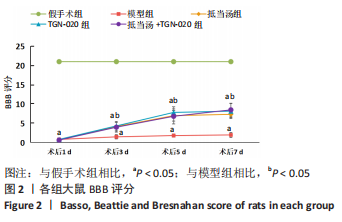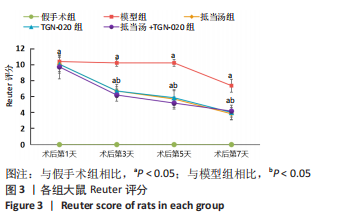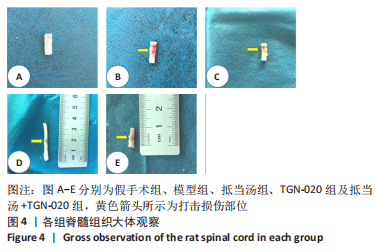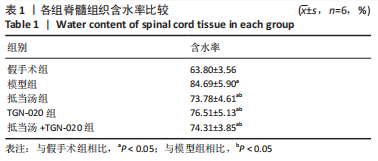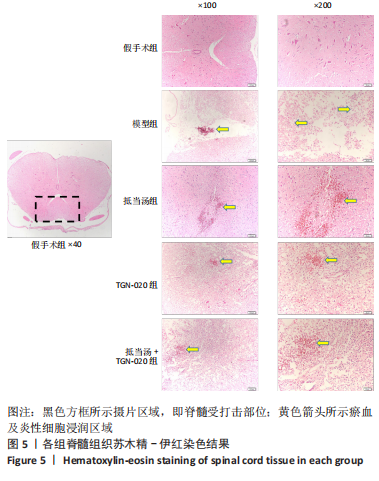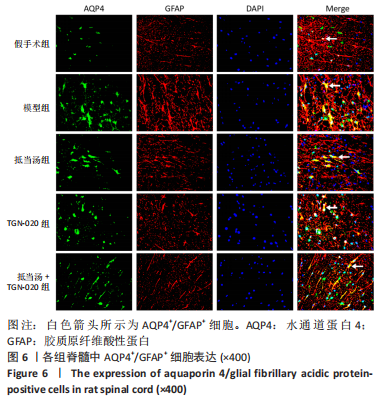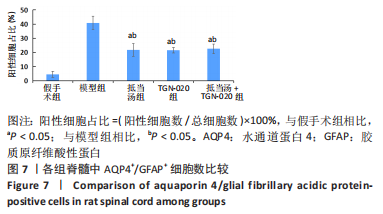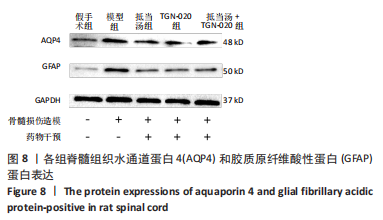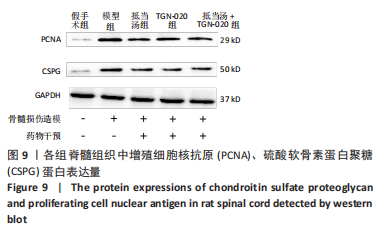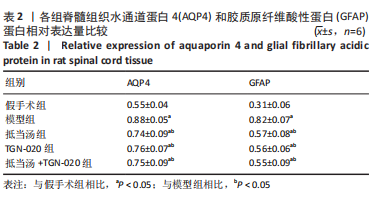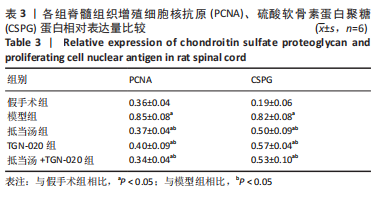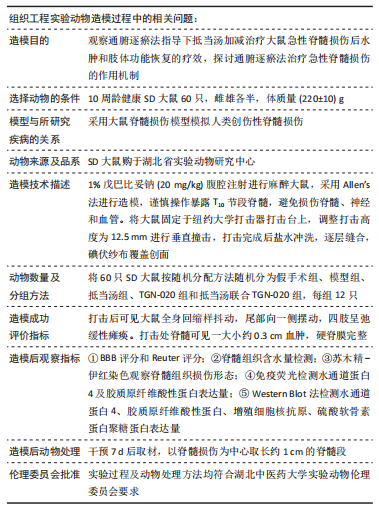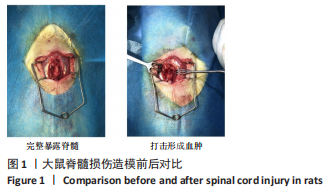中国组织工程研究 ›› 2023, Vol. 27 ›› Issue (20): 3180-3187.doi: 10.12307/2023.529
• 组织构建实验造模 experimental modeling in tissue construction • 上一篇 下一篇
通腑逐瘀法指导下抵当汤加减可抑制大鼠急性脊髓损伤后胶质瘢痕的形成
文 峰1,2,3,4,周 磊1,李 扬2,3,4,郑力铭1,张志文1,2,3,4,范 筱5,吴子健2,3,4
- 1湖北中医药大学,湖北省武汉市 430065;2湖北中医药大学附属医院,湖北省武汉市 430061;3湖北省中医院,湖北省武汉市 430061;
4湖北省中医药研究院,湖北省武汉市430061;5青岛市市立医院,山东省青岛市 266011
Jiajian Didang Tang inhibits glial scar formation in rats with acute spinal cord injury under the guidance of Tongfu Zhuyu therapy
Wen Feng1, 2, 3, 4, Zhou Lei1, Li Yang2, 3, 4, Zheng Liming1, Zhang Zhiwen1, 2, 3, 4, Fan Xiao5, Wu Zijian2, 3, 4
- 1Hubei University of Chinese Medicine, Wuhan 430065, Hubei Province, China; 2Affiliated Hospital of Hubei University of Chinese Medicine, Wuhan 430061, Hubei Province, China; 3Hubei Provincial Hospital of TCM, Wuhan 430061, Hubei Province, China; 4Hubei Academy of TCM, Wuhan 430061, Hubei Province, China; 5Qingdao Municipal Hospital, Qingdao 266011, Shandong Province, China
摘要:
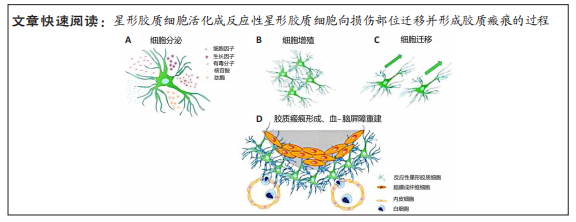
文题释义:
脊髓损伤:脊髓损伤是指因创伤致机械应力集中于脊柱,使脊柱发生骨折、脱位,椎体失去稳定性,脊髓或马尾神经受到挤压,血脊髓屏障被破坏,产生局部水肿、炎症、缺血、缺氧等病理改变,引起损伤节段以下运动、感觉功能丧失,神经反射和自主排便排尿功能障碍的一类疾病。星形胶质细胞:是哺乳动物脑内分布最广泛的一类细胞,也是胶质细胞中体积最大的一种。星形胶质细胞具有许多突起,伸展充填在神经细胞的胞体及其突起之间,起支持和分隔神经细胞的作用,并参与了血脑屏障的形成。星形胶质细胞能对外源性化合物进行生物转化,并可帮助调节神经元周围的离子微环境。外源性化学物质或创伤损伤中枢神经系统后,损伤区域星形胶质细胞通过增生可形成胶质瘢痕。
背景:急性脊髓损伤具有较高的致残率和致死率,在急性期进行积极有效的治疗对预防继发性损害具有重要意义。
目的:观察通腑逐瘀法指导下抵当汤加减治疗大鼠急性脊髓损伤后水肿和肢体功能恢复的疗效,探讨通腑逐瘀法治疗急性脊髓损伤的作用机制。
方法:将60只SD大鼠随机分为假手术组、模型组、抵当汤组、TGN-020组以及抵当汤+TGN-020组,每组12只。假手术组行椎板切除术,不予脊髓打击,其余各组均采用纽约大学打击器制造急性脊髓损伤模型。造模成功后,假手术组和模型组不采取任何治疗措施,抵当汤组术后给予5.04 g/kg抵当汤灌胃;TGN-020组术后给予5 mg/kg TGN-020(水通道蛋白4特异性抑制剂)腹腔注射;抵当汤联合TGN-020组术后采用5 mg/kg TGN-020腹腔注射联合5.04 g/kg抵当汤灌胃处理,1次/d,持续7 d。分别于术后1,3,5,7天评估BBB评分和Reuter评分,术后第7天取材进行脊髓组织大体观察和含水率检测,苏木精-伊红染色观察组织受损程度,免疫荧光检测各组脊髓组织中水通道蛋白4和胶质原纤维酸性蛋白共表达细胞个数,Western Blot法检测各组脊髓组织中水通道蛋白4、胶质原纤维酸性蛋白、硫酸软骨素蛋白聚糖、增殖细胞核抗原蛋白的表达量。
结果与结论:①行为学评分结果显示,与模型组相比,各用药组BBB评分均显著升高(P < 0.05),Reuter评分均显著降低(P < 0.05),且各用药组之间无显著差异(P > 0.05);②脊髓组织含水率结果显示,与模型组相比,各用药组脊髓组织含水率均显著降低(P < 0.05),且各用药组之间无显著差异(P > 0.05);③苏木精-伊红染色结果显示,模型组脊髓组织结构离乱,大量瘢痕组织和脊髓空洞形成;与模型组相比,各用药组可见组织结构较完整,可见少量瘢痕组织增生和脊髓空洞,组织形态得到有效改善;④免疫荧光结果显示,与模型组相比,各用药组水通道蛋白4和胶质原纤维酸性蛋白共表达细胞数量较少,亮度较低,细胞肿胀程度减轻(P < 0.05),且各用药组之间无显著差异(P > 0.05);⑤Western Blot结果显示,与模型组相比,各用药组脊髓组织中水通道蛋白4、胶质原纤维酸性蛋白、硫酸软骨素蛋白聚糖、增殖细胞核抗原蛋白的表达均显著降低(P < 0.05),且各用药组之间无显著差异(P > 0.05);⑥提示通腑逐瘀法指导下抵当汤加减可促进急性脊髓损伤大鼠肢体功能恢复,其作用机制可能通过抑制水通道蛋白4表达减轻急性脊髓损伤大鼠损伤处水肿,从而有效抑制反应性星形胶质细胞的活化和增生,减少胶质瘢痕的形成。
https://orcid.org/0000-0001-8378-4514(文峰)
中国组织工程研究杂志出版内容重点:组织构建;骨细胞;软骨细胞;细胞培养;成纤维细胞;血管内皮细胞;骨质疏松;组织工程
中图分类号:
